
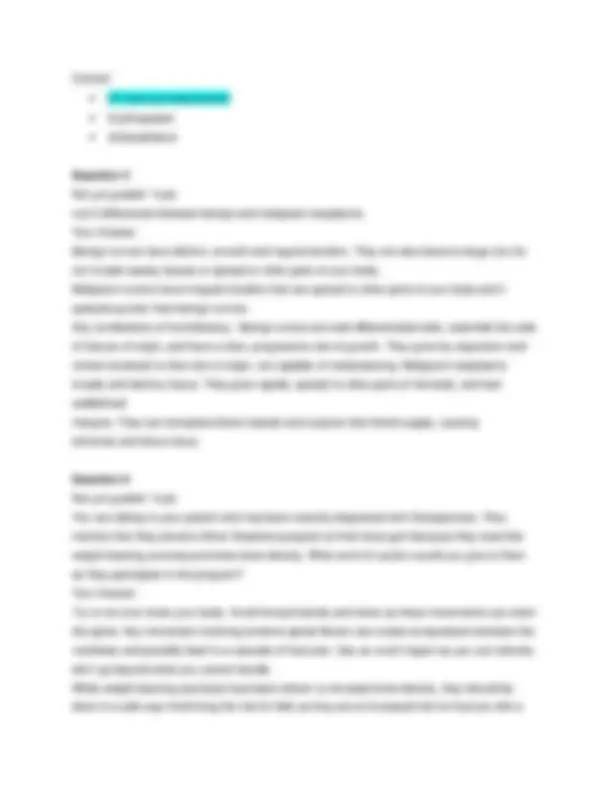
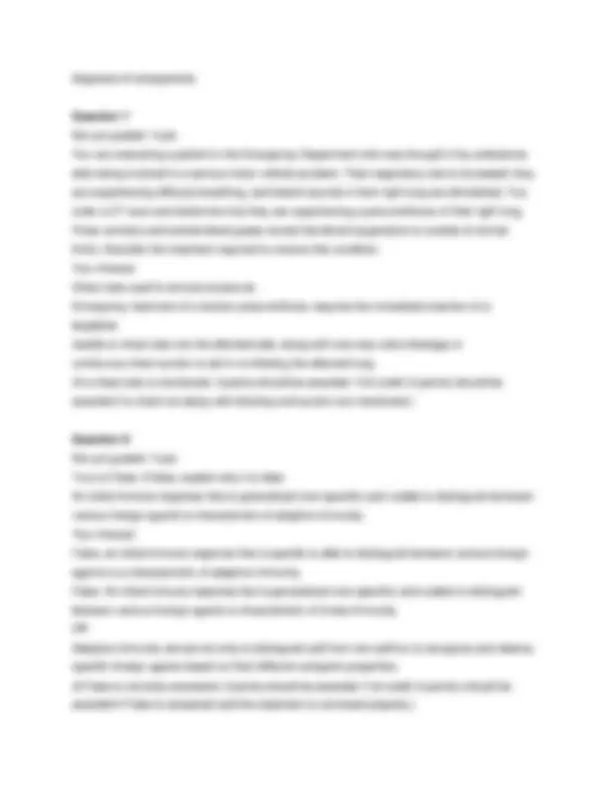
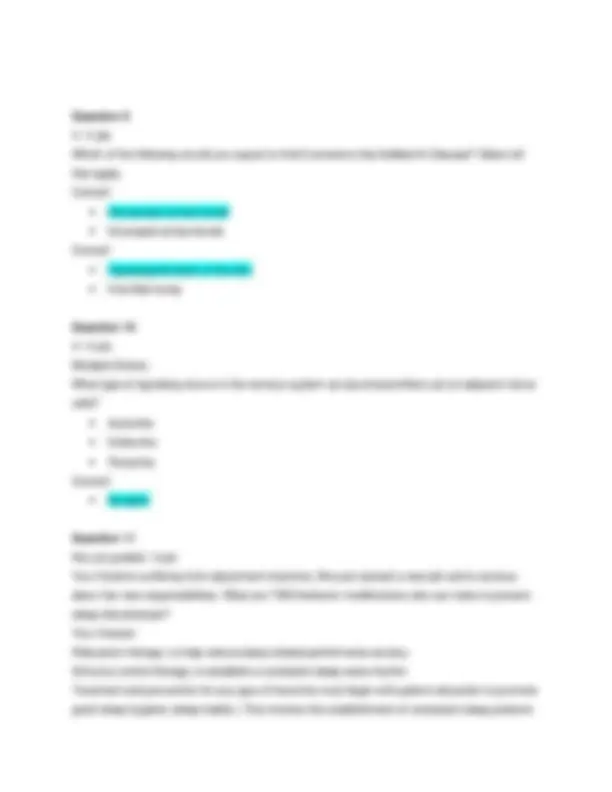
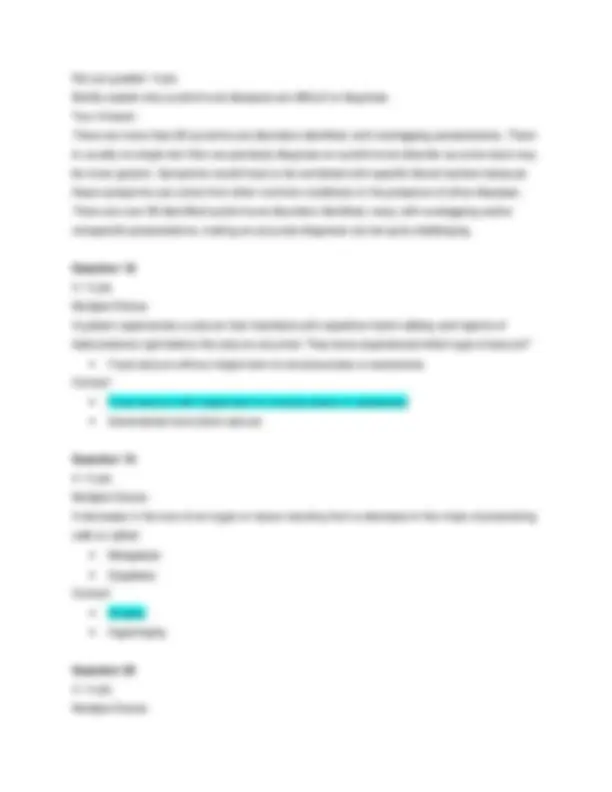
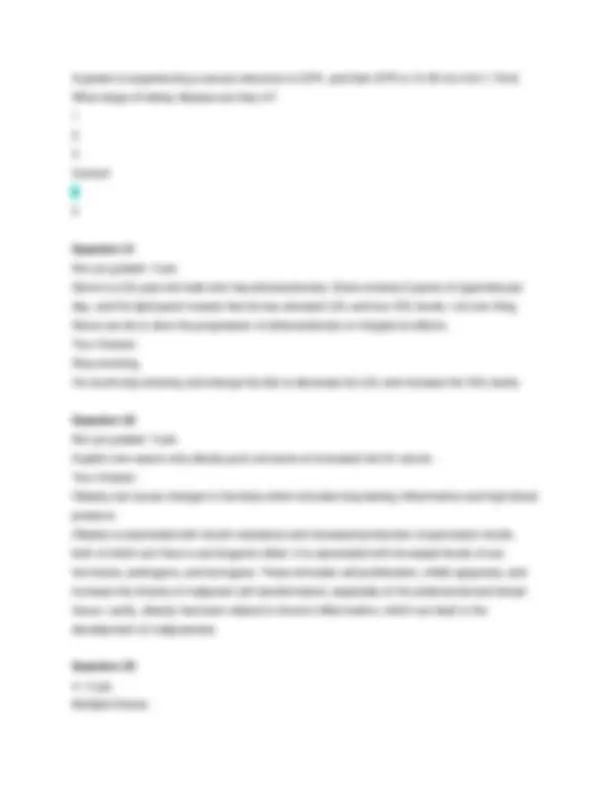
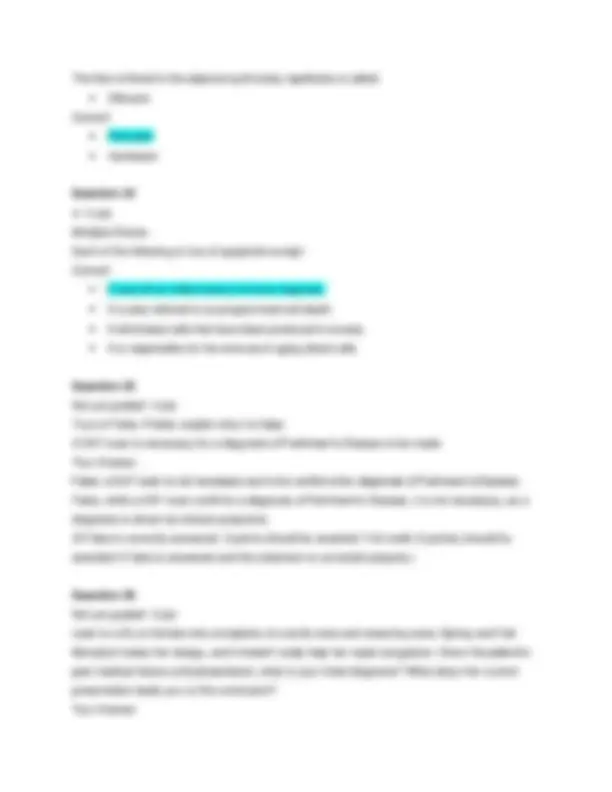
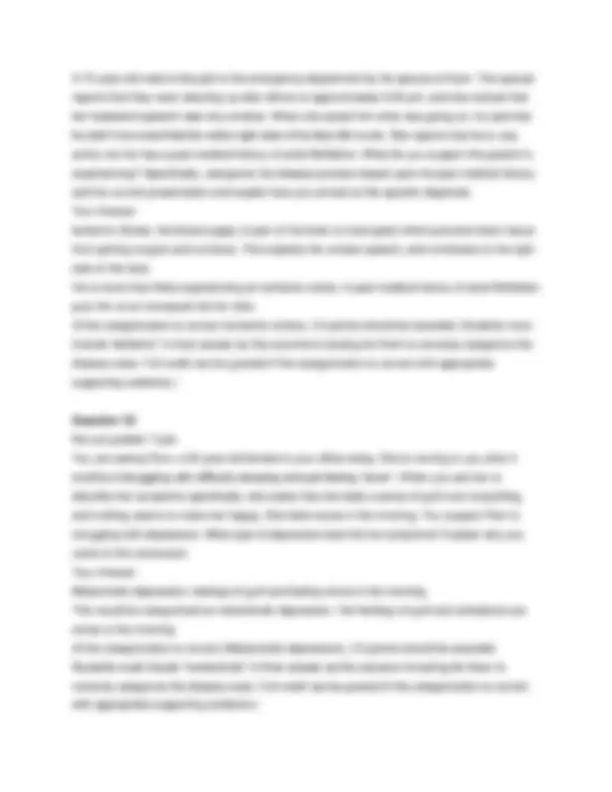
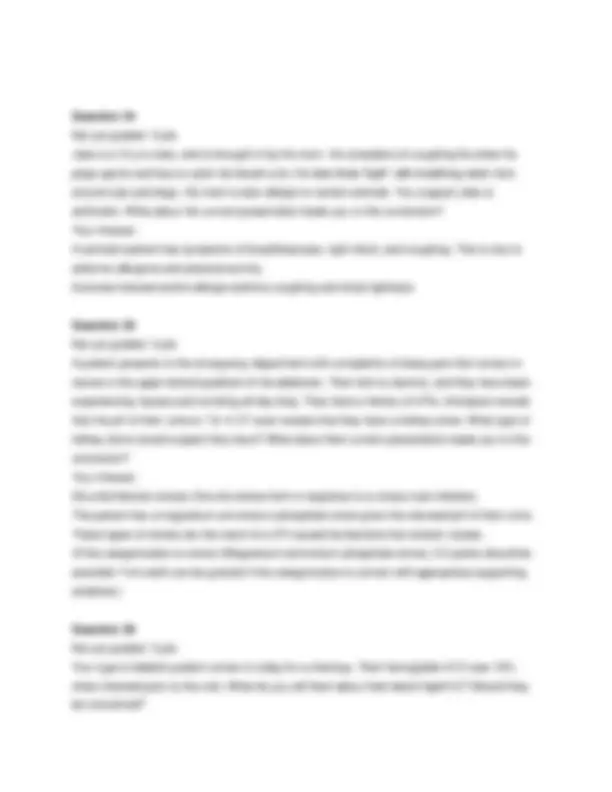
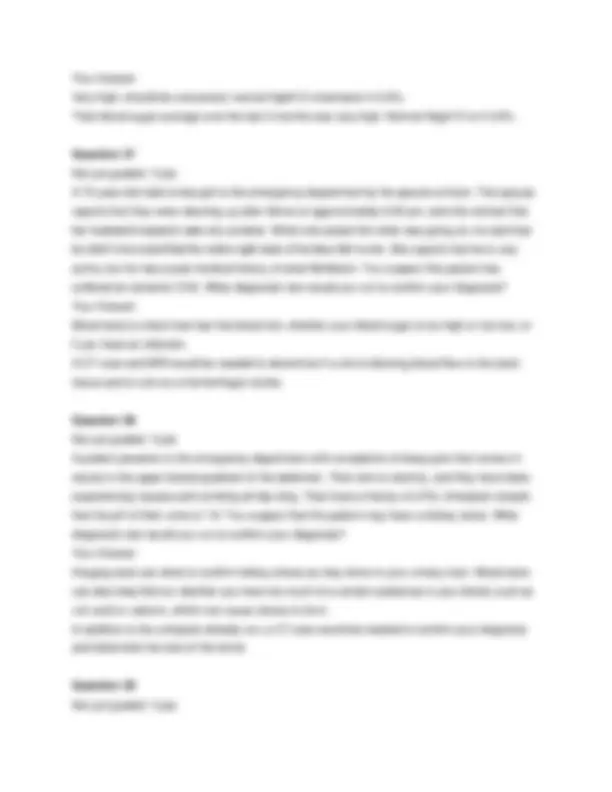
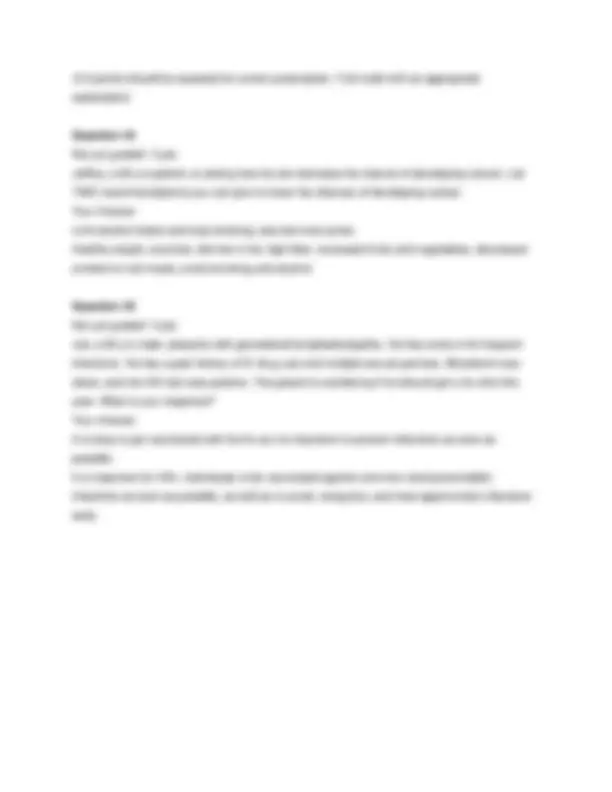


Study with the several resources on Docsity

Earn points by helping other students or get them with a premium plan


Prepare for your exams
Study with the several resources on Docsity

Earn points to download
Earn points by helping other students or get them with a premium plan
Community
Ask the community for help and clear up your study doubts
Discover the best universities in your country according to Docsity users
Free resources
Download our free guides on studying techniques, anxiety management strategies, and thesis advice from Docsity tutors
A comprehensive set of questions and answers covering various topics in nurs 231, a nursing course. It includes multiple choice questions, fill-in-the-blank questions, and short answer questions. Designed to help students prepare for their final exam in nurs 231. It covers topics such as primary, secondary, and tertiary prevention, physiology of the digestive system, blood panel analysis, vitamin d, benign and malignant neoplasms, osteoporosis, pneumothorax, immune response, addison's disease, nervous system signaling, insomnia, osteoarthritis, gout, tissue function and repair, triglycerides, gerd, and autoimmune diseases.
Typology: Exams
1 / 18

This page cannot be seen from the preview
Don't miss anything!











Question 1 4 / 4 pts Multiple Choice: You are seeing a patient in your clinic who recently suffered a TIA. Recent diagnostic tests revealed that he has atrial fibrillation. You decide to put him on a blood thinner to prevent a future neurologic event. This would be an example of:
diagnosis of osteoporosis. Question 7 Not yet graded / 4 pts You are evaluating a patient in the Emergency Department who was brought in by ambulance after being involved in a serious motor vehicle accident. Their respiratory rate is increased; they are experiencing difficulty breathing, and breath sounds in their right lung are diminished. You order a CT scan and determine that they are experiencing a pneumothorax of their right lung. Pulse oximetry and arterial blood gases reveal that blood oxygenation is outside of normal limits. Describe the treatment required to reverse this condition. Your Answer: Chest tube used to remove excess air. Emergency treatment of a tension pneumothorax requires the immediate insertion of a largebore needle or chest tube into the affected side, along with one-way valve drainage or continuous chest suction to aid in re-inflating the affected lung. (If a chest tube is mentioned, 3 points should be awarded. Full credit (4 points) should be awarded if a chest tub along with draining and suction are mentioned.) Question 8 Not yet graded / 4 pts True or False. If false, explain why it is false. An initial immune response that is generalized (non-specific) and unable to distinguish between various foreign agents is characteristic of adaptive immunity. Your Answer: False, an initial immune response that is specific is able to distinguish between various foreign agents is a characterisitic of adaptive immunity. False. An initial immune response that is generalized (non-specific) and unable to distinguish between various foreign agents is characteristic of innate immunity. OR Adaptive immunity serves not only to distinguish self from non-self but to recognize and destroy specific foreign agents based on their different antigenic properties. (If False is correctly answered, 3 points should be awarded. Full credit (4 points) should be awarded if False is answered and the statement is corrected properly.)
Question 9 4 / 4 pts Which of the following would you expect to find if someone has Addison’s Disease? Select all that apply. Correct!
2 / 4 pts Which of the following is/are characteristic of normal tissue function, renewal and repair? Select all that apply. Correct Answer
Not yet graded / 4 pts Briefly explain why autoimmune diseases are difficult to diagnose. Your Answer: There are more than 80 autoimmune disorders identified, with overlapping presentations. There is usually no single test that can precisely diagnose an autoimmune disorder as some tests may be more generic. Symptoms would have to be combined with specific blood markers because these symptoms can come from other common conditions in the presence of other diseases. There are over 80 identified autoimmune disorders identified, many with overlapping and/or nonspecific presentations, making an accurate diagnosis can be quite challenging. Question 18 4 / 4 pts Multiple Choice: A patient experiences a seizure that manifests with repetitive hand rubbing and reports of hallucinations right before the seizure occurred. They have experienced which type of seizure?
The flow of blood in the adjacent pulmonary capillaries is called:
Allergic rhinitis; stuffy nose and sneezing in the spring and fall possibly due to breathing in tiny particles of allergens. Allergic rhinitis. Sneezing and congestion that present when pollen counts are high leads us to this conclusion. (If the diagnosis is correct, 3.5 points should be awarded. Full credit should be granted if the diagnosis is correct with appropriate supporting evidence.) Question 27 Not yet graded / 5 pts Jeffrey, a 62 y/o patient, presents with progressing shortness of breath, profound iron deficiency, and is hemoccult positive (blood in stool). What specialist would you send him to and why? Your Answer: Hematologist; deals with blood cells. An oncologist because you want to rule out cancer. Partial credit can be given for Gastroenterologist or Hematologist if they can answer why. For example, pt needs a colonoscopy or need to find source of bleeding. (If the appropriate specialist is identified, 3.5 points should be awarded. Full credit should be granted if the correct specialist is identified with an appropriate explanation.) Question 28 Not yet graded / 5 pts Bill and Angela have brought their mom into your office today. They tell you that their mom has experienced dementia for some time now, but they have not been too concerned because, for the most part, she has been able to care for herself, only needing assistance here and there for her daily activities. However, recently things have changed. Her ability to recall recent events has drastically decreased; she is experiencing difficulty with sleep; they’ve noticed some mood changes, and the most alarming thing is that she has started to wander outside of her home. They are concerned for her safety. Given the patient’s presentation, what is your initial diagnosis? Your Answer: Initial diagnosis is Alzheimer's disease. Alzheimer’s Disease
A 75 - year-old male is brought to the emergency department by his spouse at 8 pm. The spouse reports that they were cleaning up after dinner at approximately 6:30 pm, and she noticed that her husband’s speech was very unclear. When she asked him what was going on, he said that he didn’t know and that the entire right side of his face felt numb. She reports that he is very active, but he has a past medical history of atrial fibrillation. What do you suspect this patient is experiencing? Specifically, categorize the disease process based upon his past medical history and his current presentation and explain how you arrived at this specific diagnosis. Your Answer: Ischemic Stroke; the blood supply to part of the brain is interrupted which prevents brain tissue from getting oxygen and nutrients. This explains his unclear speech, and numbness to the right side of this face. He is more than likely experiencing an ischemic stroke. A past medical history of atrial fibrillation puts him at an increased risk for clots. (If the categorization is correct (ischemic stroke), 3.5 points should be awarded. Students must include “ischemic” in their answer as the outcome is looking for them to correctly categorize the disease state. Full credit can be granted if the categorization is correct with appropriate supporting evidence.) Question 33 Not yet graded / 5 pts You are seeing Pam, a 52-year-old female in your office today. She is coming to you after 4 months of struggling with difficulty sleeping and just feeling “down”. When you ask her to describe her symptoms specifically, she states that she feels a sense of guilt over everything, and nothing seems to make her happy. She feels worse in the morning. You suspect Pam is struggling with depression. What type of depression best fits her symptoms? Explain why you came to this conclusion. Your Answer: Melancholic depression, feelings of guilt and feeling worse in the morning. This would be categorized as melancholic depression. Her feelings of guilt and anhedonia are worse in the morning. (If the categorization is correct (Melancholic depression), 3.5 points should be awarded. Students must include “melancholic” in their answer as the outcome is looking for them to correctly categorize the disease state. Full credit can be granted if the categorization is correct with appropriate supporting evidence.)
Question 34 Not yet graded / 5 pts Jake is a 12 y/o male, who is brought in by his mom. He complains of coughing fits when he plays sports and has to catch his breath a lot. He also feels “tight” with breathing when he’s around cats and dogs. His mom is also allergic to certain animals. You suspect Jake is asthmatic. What about his current presentation leads you to this conclusion? Your Answer: A astmatic patient has symptoms of breathlessness, tight chest, and coughing. This is due to airborne allergens and physical activity. Exercise-induced and/or allergic asthma; coughing and chest tightness Question 35 Not yet graded / 5 pts A patient presents to the emergency department with complaints of sharp pain that comes in waves in the upper lateral quadrant of the abdomen. Their skin is clammy, and they have been experiencing nausea and vomiting all day long. They have a history of UTIs. Urinalysis reveals that the pH of their urine is 7.8. A CT scan reveals that they have a kidney stone. What type of kidney stone would suspect they have? What about their current presentation leads you to this conclusion? Your Answer: Struvite/infection stones; Struvite stones form in response to a urinary tract infection. The patient has a magnesium ammonium phosphate stone given the elevated pH of their urine. These types of stones are the result of a UTI caused by bacteria that contain urease. (If the categorization is correct (Magnesium ammonium phosphate stone), 3.5 points should be awarded. Full credit can be granted if the categorization is correct with appropriate supporting evidence.) Question 36 Not yet graded / 5 pts Your type 2 diabetic patient comes in today for a checkup. Their hemoglobin A1C was 10% when checked prior to this visit. What do you tell them about their latest HgbA1C? Should they be concerned?
Anne is a 48 y/o female who presents with excessive vaginal bleeding x 6 months. Her skin is pale, she reports feeling fatigued, and often craves a large cup of Sonic crushed ice. A quick inoffice H&H shows a hemoglobin of 9 and hematocrit of 30%. You suspect Anne is anemic. What diagnostic test would you run to confirm your diagnosis? What would her red blood cells look like on the slide? (size and color) Your Answer: Anemia diagnosis includes a complete blood count the number of blood cells in a sample of your blood, Low levels of red blood cells are small and paler than normal. CBC with peripheral smear and ferritin level. RBCs would appear microcytic and hypochromic. (If the diagnostic test is correctly identified, 3.5 points should be awarded. Full credit should be awarded if the tests are correct and if the description of RBCs is correct.) Question 40 Not yet graded / 5 pts 6 y/o Tommy is brought in by his mom today for complaints of vomiting and diarrhea. He does not have a fever. His stool is hemoccult negative (no blood). His younger sibling has similar symptoms. You diagnose Tommy with viral gastroenteritis. What is the best treatment plan for this patient? Explain your reasoning. Your Answer: Replacing lost fluids and electrolytes to prevent dehydration, however, specific treatment is not needed. Drink plenty of fluids and rest at home until the virus leaves your system. Fluid and electrolyte replacement to prevent dehydration. Most acute episodes of diarrhea will subside on their own and require no treatment. (An answer of dehydration prevention should be awarded 3.5 points. Full credit should be awarded if preventative measures are listed and the fact that this typically resolves on its own.) Question 41 Not yet graded / 5 pts Leah is a 25 y/o female who complains of a stuffy nose and sneezing every Spring and Fall. Benadryl makes her sleepy, and it doesn’t really help her nasal congestion. You believe Leah is suffering from a simple case of allergic rhinitis. What is the best treatment plan for this patient? Explain your reasoning. Your Answer:
Allergen avoidance or antihistamines (oral and intranasal). Intranasal is sprayed into the nostrils to produce a local effect directly inside the nose. This will help relieve congestion in your nose. 2nd generation antihistamine (non-drowsy) and intranasal steroid for symptom management. (3.5 points should be awarded if the appropriate medication is identified. Full credit should be awarded with an appropriate explanation.) Question 42 Not yet graded / 5 pts A 75 - year-old male is brought to the emergency department by his spouse at 8 pm. The spouse reports that they were cleaning up after dinner at approximately 6:30 pm, and she noticed that her husband’s speech was very unclear. When she asked him what was going on, he said that he didn’t know and that the entire right side of his face felt numb. She reports that he is very active, but he has a past medical history of atrial fibrillation. A CT scan confirms that this patient has suffered from an ischemic CVA. What is the best treatment plan for this patient? Explain your reasoning. Your Answer: An IV injection of TPA given through a vein in the arm is the best treatment plan for this patient, especially since he came within the first three hours of injury. tPA breaks up the blood clots. This patient should receive tPA drugs, as they are within the 3-4.5 hour treatment window. (3.5 points should be awarded if tPA drugs are identified as the treatment of choice. Full credit should be awarded with an appropriate explanation.) Question 43 Not yet graded / 5 pts Sydney, an 18 y/o female, presents with constipation, fatigue, and dry skin. Her menstrual periods have gotten heavier, and she has gained 15 lbs since her last visit. Sydney’s lab results confirm a diagnosis of hypothyroidism. What treatment would you prescribe? Explain your reasoning for choosing this treatment plan. Your Answer: Treatment for hypothyroidism involves the daily use of synthetic thyroid hormone to restore adequate hormone levels and reversing the signs and symptoms of hypothyroidism. Synthetic T4 thyroid hormone, thyroxine. Sydney’s thyroid isn’t producing enough thyroid hormone, so you need to replace it.